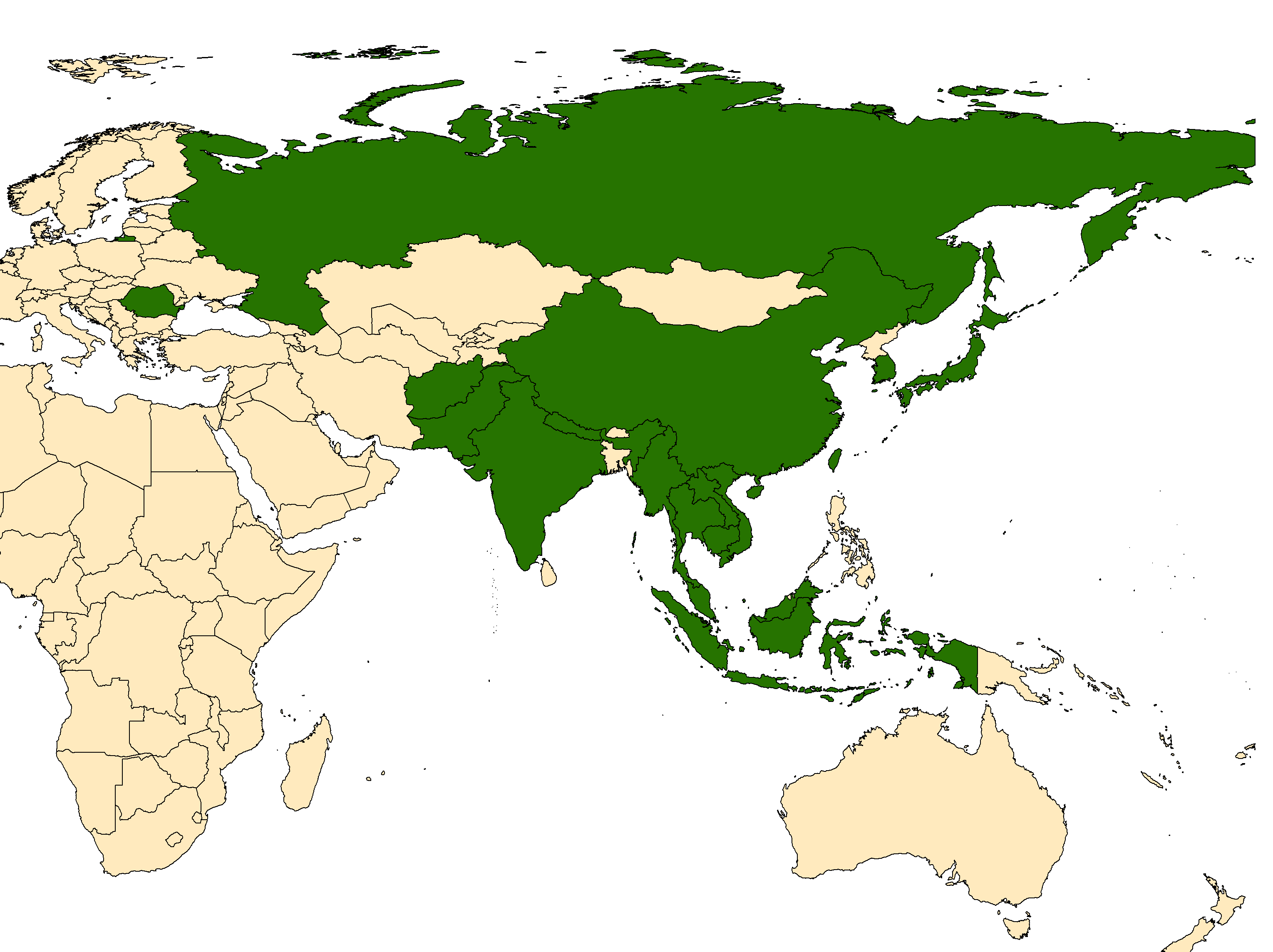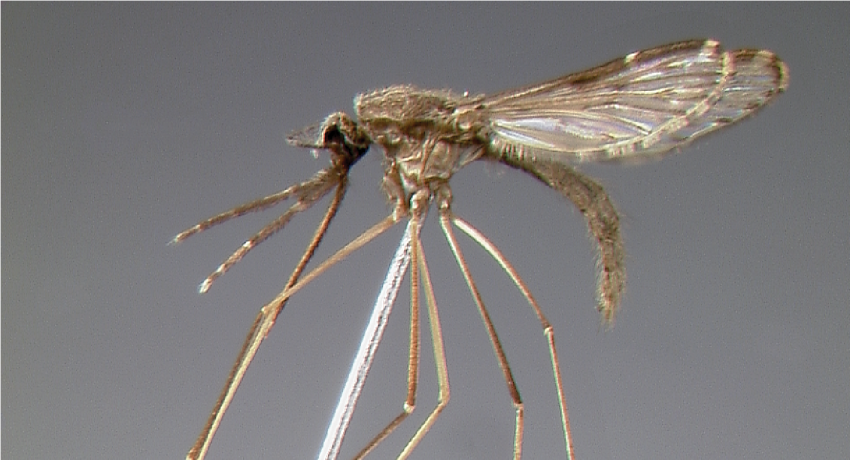ORIENTAL & PALEARCTIC REGIONS
Etymology: China
Anopheles sinensis is one of 16 unplaced members of the Hyrcanus Group, which also includes members of the Lesteri Subgroup and Nigerrimus Subgroups. Anopheles sinensis has three synonyms: plumiger Dönitz, jesoensis Tsuzuki, and changfus Ma. As there are so many new species in the Hyrcanus Group, previously hidden under and reported as An. sinensis, assigning the bionomic attributes and medical importance of each of the component taxa can be difficult. Although An. sinensis is implicated in malaria transmission, but is nowhere near as effective a vector as other Hyrcanus group members such as An. nigerrimus Giles, An. lesteri Baisas & Hu, An. pullus Yamada, or An. kleini Rueda.
Type locality: [Canton], China [People’s Republic of China]
Type depository: Universitetets Zoologiske Museum, Copenhagen, Denmark (ZMC)
DIAGNOSTIC CHARACTERS (Click photos to view; mouse over and click large photo to zoom in.)
ADULT (illustrated): Head: Flagellum with basal 4–8 flagellomeres with pale scales; clypeus with patch of dark scales laterally; MPlp3 with pale basal band at most as wide as other pale bands. Thorax: Capitellum of haltere dark; antepronotal scales present; C-II with distinct upper patch of pale scales. Legs: Fe-III without distal broad preapical white band; Ta-III1–5 with apical pale bands only. Wing: Costa usually without humeral pale spot; CuA usually present; presector pale spot ill-defined or absent; vein 1A with 2 dark spots; wing apex with narrow pale fringe spot, not extending beyond veins R1 to R3; pale fringe spot usually present at termination of vein CuA.
LARVA (not illustrated): Head: Antenna (A) spiculate; seta 1-A with long branches reaching beyond midpoint of antenna; seta 2-C single, closely approximated; seta 3-C with ≥10 branches. Thorax: Seta 1-P without branches on basal 0.5, single or with short branches on distal 0.5. Abdominal segments: Seta 1 fully developed palmate on at least 5 segments.
TAXONOMIC KEYS
Nguyen Thuong Hien 1968
Lee et al. 1987b
Darsie & Pradhan 1990
Rattanarithikul et al. 2006b
Becker et al. 2010
![]()
WRBU - Anopheles - Myzorhynchus Series - Indomalayan Region - Adult
![]()
WRBU - Anopheles - Myzorhynchus Series - Indomalayan Region - Larva
![]()
WRBU - Anopheles - Myzorhynchus Series - Oriental Region - Adult
![]()
WRBU - Anopheles - Myzorhynchus Series - Oriental Region - Larva
![]()
WRBU - Genera - Global - Adult
![]()
WRBU - Genera - Global - Larva
![]()
WRBU - Genera - Eastern Palearctic - Adult
![]()
WRBU - Genera - Eastern Palearctic - Larva
![]()
WRBU - Genera - Indomalaya - Adult
![]()
WRBU - Genera - Indomalaya - Larva
![]()
WRBU - Genera - Oriental - Adult
![]()
WRBU - Genera - Oriental - Larva
![]()
WRBU - Anopheles Subgenera and Series - Indomalaya - Adult
![]()
WRBU - Anopheles Subgenera and Series - Indomalaya - Larva
![]()
WRBU - Anopheles Subgenera and Series - Oriental - Adult
![]()
WRBU - Anopheles Subgenera and Series - Oriental - Larva
Exemplar DNA sequences
An. sinensis COI: AB781782–84
Whole genome: ID: 12170
BIONOMICS
Immatures
Immature An. sinensis are found in a wide variety of open, freshwater habitats, with emergent and /or floating vegetation. They are common in shallow waters in rice fields, grassy flood pools, seepage waters, marshes, swamps and ponds, and are often reported in smaller habitats including stream and rock pools, and wheel ruts.
Adults
Female An. sinensis are essentially zoophilic, biting man only when other preferred mammals are absent. In South Korea, cattle and buffalo are preferred hosts (89.8%), but in Taiwan, 86.4% of blooded An. sinensis had fed on pigs, and only 9.1% of meals were bovine. The species is dominantly exophilic and exophagic, and rarely found indoors. In northern parts of their range, adult females overwinter as mated nullipars, typically entering diapause when temperatures drop to 13-15°C.
DISTRIBUTION NOTES
Afghanistan, Cambodia, India, Indonesia (includes Kalimantan, Java, Flores, Sulawesi, Sumatra includes Ketulauan Riouw Archipelago, Timor), Japan, Laos, Macau, Malaysia, Myanmar, Nepal, Pakistan, People's Republic of China (includes Hong Kong), Russia, Serbia & Montenegro, Singapore, South Korea, Taiwan, Thailand, Timor, Vietnam.

WRBU VECTOR HAZARD REPORTS
View other WRBU Vector Hazard Reports
Available GIS Models:
An_sinensis_Foley_1 Palaearctic
IMPORTANT REFERENCES (full citations below)
Wiedemann, 1828: 547 (M, F).
Bohart & Ingram 1946b: 51 (M*, F*, L*; bionomics, distribution, taxonomy)
LaCasse & Yamaguti 1950 (F*)
Reid 1953: 10 (M*, F*, P*, L*, E*; taxonomy)
Hara 1957: 47 (F*)
Ohmori 1957 (M*, E*)
Ohmori 1959: 221 (P*)
Hara 1959 (F*)
Nguyen Thuong Hien 1968 (F*, L*; keys, taxonomy, bionomics, Vietnam)
Harrison 1973b: 7 (lectotype designation; distribution)
Lee et al. 1973: 383 (distribution)
Harrison & Scanlon 1975: 45 (M*, F*, P*, L*; distribution)
Tanaka et al. 1975c: 210 (taxonomy, distribution)
Kanda & Oguma 1976: 325 (A*; taxonomy)
Otsuru et al. 1976: 301 (E)
Kanda & Oguma 1977: 115 (hybridization with sineroides)
Tanaka et al. 1979: 72 (M*, F*, P, L*, E)
Beales 1984 (taxonomy)
Lee et al. 1987b: 94 (F key, taxonomy, bionomics, distribution, review)
Darsie & Pradhan 1990 (F, L; taxonomy, keys, bionomics, distribution; Nepal)
Linley et al. 1995: 44 (E*)
Gornostaeva 2000: 477 (distribution; Russia)
Whelan & Hapgood 2000: 405 (bionomics, distribution; East Timor)
Oo et al. 2004 (distribution; Myanmar)
Rattanarithikul et al. 2006b (F*, L*; bionomics, distribution, keys)
Becker et al. 2010: 340 (F*, L*; key, taxonomy, distribution, bionomics)
Sinka et al. 2011: 89 (bionomics review, distribution, niche model)
Saeung et al. 2014 (E*)
Zhou et al. 2014 (whole genome)
Neafsey et al. 2015 (comparative genomics)
CURRENT SYNONYMS
syn. plumiger Dönitz
1901: 37 (M, F). Type locality: Hong Kong [People's Republic of China] (ZM).
syn. jesoensis Tsuzuki
1902c: 764 (M). Type locality: Hokkaido, Japan (LU). References: Reid 1953: 51 [Variously spelled as jezoensis & jezoensis].
syn. changfus Ma
1981b: 65 (M*, F*, E). Type locality: Emei, Sichuan Province, China [People's Republic of China] (IZ). References: Miao et al. 1988 (syn. with sinensis); Qu & Zhu 2008 (review; synonymy with sinensis).
CURRENT SUBSPECIES
None
CITED REFERENCES
Beales, P. F. (1984). A review of the taxonomic status of Anopheles sinensis and its bionomics in relation to malaria transmission. World Health Organization, 1–35.
Becker, N., Petrić, D., Zgomba, M., Boase, C., Madon, M., Dahl, C., & Kaiser, A. (2010). Mosquitoes and their control (Second ed.). Berlin Heidelberg: Springer-Verlag.
Bohart, R.M., & Ingram, R.L. (1946b). Mosquitoes of Okinawa and islands in the Central Pacific. In United States NAVMED (Bureau of Medicine and Surgery, Navy Department) (pp. 110). Washington.
Darsie, R.F., Jr., & Pradhan, S.P. (1990). The mosquitoes of Nepal: Their identification, distribution and biology. Mosquito Systematics, 22(2), 69–130.
Dönitz, W. (1901). Nachrichten aus dem Berliner Entomologischen Verein. Insekten -Borse, 18, 36–38.
Gornostaeva, R.M. (2000). A revised checklist of the mosquitoes (Diptera, Culicidae) of European Russia [English translation]. Parazitologiya (St. Petersburg), 34(6), 477–485.
Hara, J. (1957). Studies on the female terminalia of Japanese mosquitoes. Japanese Journal of Experimental Medicine, 27, 45–91.
Hara, J. (1959). Taxonomical notes on the female terminalia of some anopheline mosquitoes of Japan and Formosa. Taxonomic and ecological studies on mosquitoes of Japan (Part 12). Japanese Journal of Experimental Medicine, 29, 107–119.
Harrison, B.A. (1973b). A lectotype designation and description for Anopheles (An.) sinensis Wiedemann 1828, with a discussion of the classification and vector status of this and some other oriental Anopheles. Mosquito Systematics, 5(1), 1–13.
Harrison, B.A., & Scanlon, J.E. (1975). Medical entomology studies-II. The subgenus Anopheles in Thailand (Diptera: Culicidae). Contributions of the American Entomological Institute, 12(1), iv + 1–307.
Kanda, T., & Oguma, Y. (1976). Morphological variations of Anopheles sinensis Wiedemann, 1828 and A. lesteri Baisas and IIu, 1936 and frequency of clasper movements of the males of several Anopheles species during induced copulation. Japanese Journal of Sanitary Zoology, 27(4), 325–331.
Kanda, T., & Oguma, Y. (1977). Hybridization between Anopheles sinensis and Anopheles sineroides. Mosquito News, 37(1), 115–117.
La Casse, W.J., & Yamaguti, S. (1950). Mosquito fauna of Japan and Korea (with 95 original plates): Office of the Sugeon, Headquarters 8th Army, APO 343.
Lee, D.J., Hicks, M.M., Griffiths, M., Debenham, M.L., Bryan, J.H., Russell, R.C., . . . Marks, E.N. (1987b). The Culicidae of the Australasian region. Volume 5. Commonwealth Department of Health, School of Public Health and Tropical Medicine Monograph Series, 2.
Lee, H.I., Self, L.S., Hong, H.K., & Lee, K.W. (1973). Mosquito light trap surveys in Korea 1969–1971. Southeast Asian Journal of Tropical Medicine & Public Health, 4(3), 382–386.
Linley, J.R., Yap, H.H., & Damar, T.B. (1995). The eggs of four species of the Anopheles hyrcanus group in Malaysia (Diptera: Culicidae). Mosquito Systematics, 27(1), 43–71.
Ma, S. (1981b). Studies on the Anopheles (A.) sinensis group of mosquitoes in China, including four new sibling species. (In Chinese). Sinozoologia, 1, 59–70.
Miao, J., Pan, J., & Jiang, W. (1988). Hybridization and chromosome observations on six species of the Anopheles hyrcanus group in China (Diptera: Culicidae). Zoological Research, 9(3), 231–237.
Neafsey, D.E., Waterhouse, R.M., Abai, M.R., Aganezov, S.S., Alekseyev, M.A., Allen, J.E. (2015). Highly evolvable malaria vectors: the genomes of 16 Anopheles mosquitoes. Science, 347(6217), p.1258522.
Nguyen Thuong Hien (1968). The genus of Anopheles in Vietnam. Saigon: Bureau of Entomology, National Malaria Program/ Republic of Vietnam. English translation by Military Entomology Information Service. 205pp.
Ohmori, Y. (1957). On the male hypopygium of the sinensis group of anopheline mosquitoes in Japan. Acta Médica et Biological, Niigata, 5, 209–217.
Ohmori, Y. (1959). The pupae of Japanese Anopheles. Japanese Journal of Sanitary Zoology, 10, 210–225.
Oo, T.T., Storch, V., & Becker, N. (2004). Review of the Anopheles mosquitoes of Myanmar. Journal of Vector Ecology, 29(1), 21–40.
Otsuru, M., Nagashima, Y., Nakamura, Y., & Kishimoto, T. (1976). Survey of eggs of the Anopheles sinensis sibling species group in Okinawa Is. Japanese Journal of Sanitary Zoology, 27(3), 301–303.
Rattanarithikul, R., Harrison, B.A., Harbach, R.E., Panthusiri, P., & Coleman, R.E. (2006b). Illustrated keys to the mosquitoes of Thailand. IV. Anopheles. Southeast Asian Journal of Tropical Medicine and Public Health, 128(Supplement 2), 2.
Reid, J.A. (1953). The Anopheles hyrcanus group in south-east Asia. (Diptera: Culicidae). Bulletin of Entomological Research, 44, 5–76.
Saeung, A., Baimai, V., Thongsahuan, S., Otsuka, Y., Srisuka, W., Taai, K., . . . Choochote, W. (2014). Cytogenetic, cross-mating and molecular evidence of four cytological races of Anopheles crawfordi (Diptera: Culicidae) in Thailand and Cambodia. Comptes Rendus Biologies, 337(11), 625–634.
Sinka, M.E., Bangs, M.J., Manguin, S., Chareonviriyaphap, T., Patil, A.P., Temperley, W.H., ... Hay, S.I. (2011). The dominant Anopheles vectors of human malaria in the Asia-Pacific region: Occurrence data, distribution maps and bionomic précis. Parasites & Vectors, 4(1), 89.
Tanaka, K., Mizusawa, K., & Saugstad, E.S. (1979). A revision of the adult and larval mosquitoes of Japan (including the Ryukyu Archipelago and Ogasawara Islands) and Korea (Diptera: Culicidae). Contributions of the American Entomological Institute, 16, 1–987.
Tanaka, K., Saugstad, E.S., & Mizusawa, K. (1975c). Mosquitoes of the Ryukyu Archipelago (Diptera: Culicidae). Mosquito Systematics, 7(3), 207–233.
Tsuzuki, J. (1902c). Ueber die Ergebnisse meiner Malariaforschung in Hokkaido (Japan). Zentralblatt für Bakteriologie, Parasitenkunde und Infektionskrankheiten, 1,763–768.
Whelan, P., & Hapgood, G. (2000). A mosquito survey of Dili, East Timor, and implications for disease control. Arbovirus Research in Australia, 8, 405–416.
Zhou, D., Zhang, D., Ding, G., Shi, L., Hou, Q., Ye, Y., et al. (2014). Genome sequence of Anopheles sinensis provides insight into genetics basis of mosquito competence for malaria parasites. BMC genomics, 15(1), p.42.
CITE THIS PAGE
Walter Reed Biosystematics Unit (Year). Anopheles sinensis species page. Walter Reed Biosystematics Unit Website, http://wrbu.si.edu/vectorspecies/mosquitoes/sinensis, accessed on [date (e.g. 03 February 2020) when you last viewed the site].








































































































































































